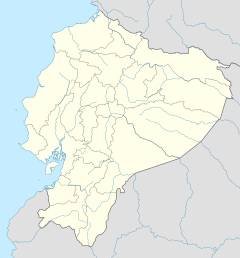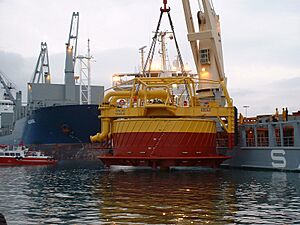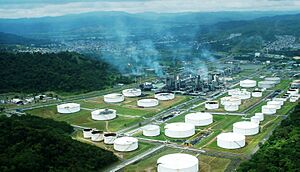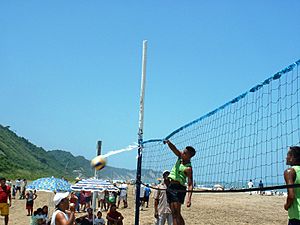Esmeraldas, Ecuador facts for kids
Quick facts for kids
Esmeraldas
|
||
|---|---|---|
|
City
|
||
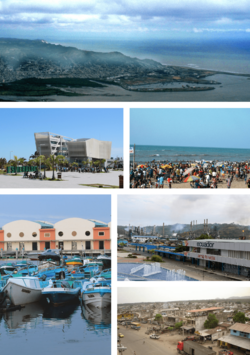
From top, left to right: View of the north of the city, Flopec building, Las Palmas beach, fishing port, Esmeraldas refinery and road to Atacames.
|
||
|
||
| Country | ||
| Province | Esmeraldas | |
| Canton | Esmeraldas | |
| Founded | September 21, 1526 | |
| Area | ||
| • City | 28.03 km2 (10.82 sq mi) | |
| Elevation | 15 m (49 ft) | |
| Population
(2022 census)
|
||
| • City | 155,487 | |
| • Density | 5,547.2/km2 (14,367.1/sq mi) | |
| Demonym(s) | Esmeraldeño - a | |
| Time zone | UTC-5 (ECT) | |
| Area code(s) | (+593) 6 | |
| Climate | Aw | |
| Website | Official website: https://www.esmeraldas.gob.ec/ | |
Esmeraldas is a lively city on the coast of northwestern Ecuador. It's the main city and capital of the Esmeraldas Province. The city has a busy international port and a small airport.
Esmeraldas is the biggest seaport in northwestern Ecuador. It is located right where the Esmeraldas River meets the Pacific Ocean. Many famous football players from Esmeraldas have played for the Ecuador national football team.
The main activities in Esmeraldas are trade, industry, and farming. The city has beautiful beaches and a warm climate. This makes it a popular place for tourists to visit. On December 19, 2016, a 5.8 magnitude earthquake shook the city.
Contents
Economy: How Esmeraldas Makes Money
The port of Esmeraldas is very important for the northern part of Ecuador. It helps the region's economy. The port of Balao is a key place for processing oil.
Wood and wood chips are the main products shipped from here. Bananas and other farm products are also sent out from the port.
Farming and Raising Animals
The soil in Esmeraldas is good for growing many crops. These include rice, corn, and African Palm. Different tropical fruits also grow well here.
Important trees in the area include chanul, laurel, and guayacán. Raising cattle and pigs is also a big part of the economy. Fishing is another key industry. Fishermen catch fish like corvina, snapper, and tuna.
Industry and Oil
Industries in Esmeraldas include manufacturing, timber, chemicals, and oil. There are some worries about how forests are managed and about deforestation. Deforestation means cutting down too many trees in the Chaco rainforest.
The Trans-Andean pipeline was finished in 1972. It connects oil fields in eastern Ecuador to the oil refinery in Esmeraldas. The oil industry is the biggest employer in the city. The refinery was made bigger in 1987 and again in 1995. It processes crude oil into different fuel products.
Climate: Weather in Esmeraldas
Like most of Ecuador's coast, Esmeraldas has a hot semi-arid climate. This means it's usually very warm or hot and often cloudy. It has a wet season from January to April. The dry season lasts from May to December. The weather is affected by fog from the Humboldt Current.
| Climate data for Esmeraldas (Tachina), elevation 8 m (26 ft), (1971–2000) | |||||||||||||
|---|---|---|---|---|---|---|---|---|---|---|---|---|---|
| Month | Jan | Feb | Mar | Apr | May | Jun | Jul | Aug | Sep | Oct | Nov | Dec | Year |
| Mean daily maximum °C (°F) | 28.8 (83.8) |
29.0 (84.2) |
29.3 (84.7) |
29.3 (84.7) |
29.1 (84.4) |
28.7 (83.7) |
28.4 (83.1) |
28.5 (83.3) |
28.5 (83.3) |
28.6 (83.5) |
28.7 (83.7) |
28.5 (83.3) |
28.8 (83.8) |
| Mean daily minimum °C (°F) | 22.3 (72.1) |
22.4 (72.3) |
22.6 (72.7) |
22.5 (72.5) |
22.7 (72.9) |
22.4 (72.3) |
22.0 (71.6) |
21.8 (71.2) |
21.7 (71.1) |
21.9 (71.4) |
22.0 (71.6) |
22.2 (72.0) |
22.2 (72.0) |
| Average precipitation mm (inches) | 89.0 (3.50) |
89.0 (3.50) |
143.0 (5.63) |
74.0 (2.91) |
53.0 (2.09) |
34.0 (1.34) |
21.0 (0.83) |
14.0 (0.55) |
15.0 (0.59) |
10.0 (0.39) |
11.0 (0.43) |
22.0 (0.87) |
575 (22.63) |
| Average relative humidity (%) | 82 | 85 | 84 | 83 | 83 | 83 | 82 | 80 | 81 | 80 | 79 | 80 | 82 |
| Source: FAO | |||||||||||||
Tourism: Fun Things to Do
Esmeraldas has many cool places to visit. You can enjoy the beautiful beaches and untouched forests. You can also learn about the culture of the local Cayapas people.
The city is known for its marimba and Afro-Ecuadorian music. The La Tolita archaeological zone is another interesting spot.
Other nearby attractions include:
- Atacames: Famous for its "crazy coconut" drink (coco-loco) and handmade crafts.
- Same: An area with big palm trees and calm blue waters.
- Muisne: Has clean beaches with warm sand and red crabs.
- Quinindé: Known for its large African palm trees and houses made of guadúa (a type of bamboo).
- Tonsupa: A great place to watch amazing sunsets.
Infrastructure: Getting Around
The main road runs along the coast. It connects towns like La Tola, Lagarto, and Río Verde. Other roads link Esmeraldas to popular places like Atacames and Muisne. You can also travel to Santo Domingo and Quito from Esmeraldas.
The train network from Quito to San Lorenzo is still used. The Carlos Concha Torres International Airport offers flights to other cities.
Notable People from Esmeraldas
- Francisco de Arobe (born 1543), a mulatto chief.
- Pervis Estupiñán (born 1998), a footballer who plays for Brighton & Hove Albion.
- Darwin Rivas (born 1990), a footballer.
- Enner Valencia (born 1989), a footballer who plays for Fenerbahçe and is the captain of the Ecuador national football team.
- Gustavo Vallecilla (born 1999), a footballer for Columbus Crew.
See also
 In Spanish: Esmeraldas (Ecuador) para niños
In Spanish: Esmeraldas (Ecuador) para niños



